Samsung QN85A Reviewed at $1,600.00 (55")
Product Name: Samsung QN85A
Product Description: 2021 4K Neo QLED TV
-
Design - 9.5/10
9.5/10
-
Video Quality - 9/10
9/10
-
Ports & Connectivity - 9/10
9/10
-
OS, Apps and Features - 9.5/10
9.5/10
-
Price / Quality - 9.2/10
9.2/10
Summary
Reviewed at $1,600.00 (55″)
Pros
- Very nice HDR brightness
- Great color reproduction
- Very good for gaming
- Tizen
Cons
- Mediocre contrast
- Blooming is still visible
- No DTS Support
- No Dolby Vision
Cheapest Places to Buy :
*We are a reader-supported website. When you buy through links on our site, we may earn a small affiliate commission at no extra cost to you. Home Media Entertainment does not accept money for reviews.*
In today’s article we will continue our venture into Neo QLED territory. With the arrival of this new LED LCD technology Samsung made sure to use it not only in their very best top-tier models but scaled it in order to make the technology a bit more affordable to the general masses. And as such in our Samsung QN85A review today we will be looking into the most budget friendly 4K Neo QLED on offer and if it has what it takes to be part of the new Neo QLED family.
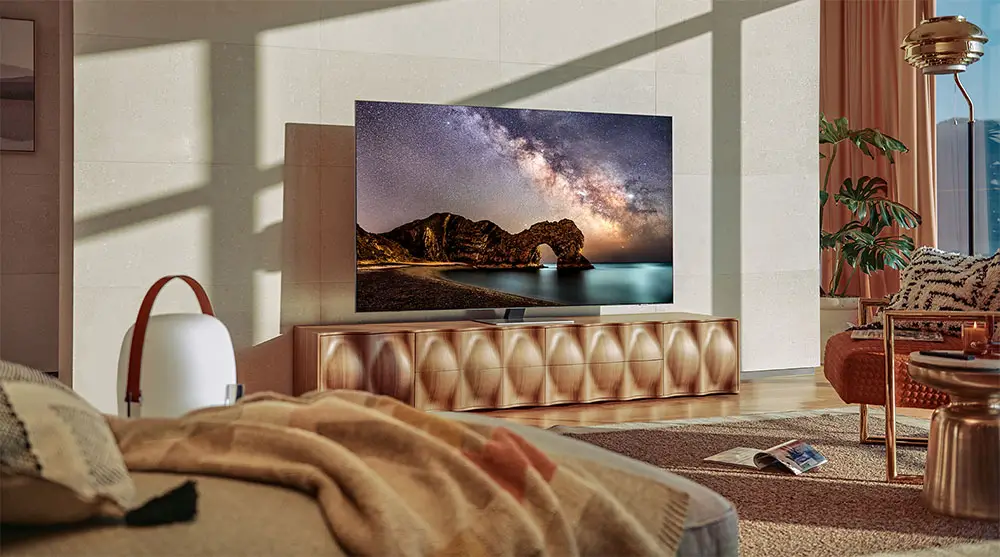
The QN85A is actually a step down from the QN90A 4K flagship, or the QN95A if you take into account the European only equivalent with the added One Connect Box, but it does share many of the same technologies being used by the other Neo QLEDs while tonning down some of its specs enough to be offered in a more lucrative price.
As such we once again find the new mini LED backlight system that uses smaller LEDs than conventional FALD systems, comes with the same Neo Quantum Processor 4K, utilizes a 120Hz panel and packs all the bells and whistles you would find in such a TV with HDR10+ support, Samung’s Object Tracking Sound system, HDMI 2.1 and FreeSync Premium Pro. Along with the rest, the new Tizen for 2021 comes fully packed as we find all functionality from previous years along with some new additions like the Game Bar, Samsung Health and more.
The QN85A is an interesting addition. From the one hand you get a Neo QLED which everyone talks about but there are certain reductions that surely will affect its overall performance. Did Samsung managed to find a good balance between performance and price? Keep reading as we put it to the test.
Design
Once again we are disappointed to see that Samsung keeps the One Connect Box for only a fraction of their releases. Instead of making it a unique feature for their TVs like Philips has Ambilight for example they instead use it only for their top flagships. Keep in mind that in the US they don’t have a single 4K model that uses this and only the European QN95A is getting it which is a huge head scratching decision. Basically its the same as they did last year so we don’t find any changes on where they are using the One Connect Box. Huge potential is lost with this decision in our opinion.
In terms of design the QN85A is extremely similar to the QN90A we had tested recently. In fact the only thing that gives it away is the slightly different stand design, otherwise you cannot tell which is which. Once again we find what Samsung calls their NeoSlim Design. Basically this comes down to the fact that the QN85A instead of using a Full Array with Local Dimming backlight system uses the new mini LED one which helps to minimize its overall thickness greatly which in the new models is just 1.06″ (2.7 cm) making it look amazing when hanged on the wall.
The entire back face is entirely the same as the QN90A and is covered by a plastic panel that in true Samsung fashion has a brushed texture look on it. We even went back and forth between the two models to verify that they have exactly the same design and layout. All ports are grouped together in an inset that is placed at the left side and all look sideways for easier access if you have it on a wall while on the lower part there are special grooves in order to place your cables and drive them through the central stand. The power connector is placed on the right side while the only other thing at the back is the holes for a VESA wall mount.
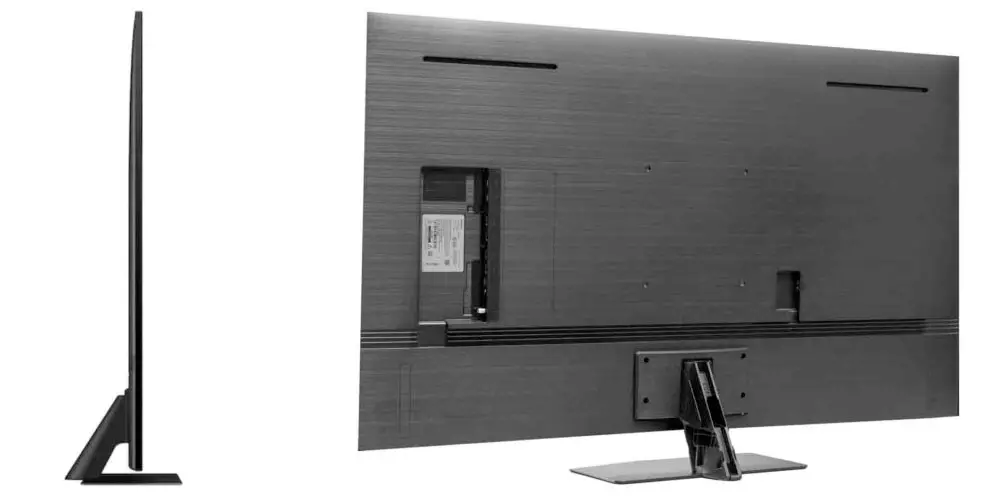
As for the stand, this is probably the only aspect of this TV that looks different from the QN90A. The QN85A still uses a central stand but is slightly wider and instead of the curvy design the QN90A had, this one is like a central pedestal. The base of the stand is made out of metal, probably to give some more weight to it while the connecting part is made out of plastic with the back of it being hollow in order to let the cables go through it for better cable management.
As for the remote once again there are no differences compared to the one we used with the QN90A and it seems that Samsung is using the same in all their Neo QLED models. For 2021 Samsung decided to make a facelift on their One Remote and while fundamentally it’s the same one we have seen the last few years we do find some noteworthy changes. First of all its shell has been redesigned and frankly it looks more premium now than before. Buttons layout has remained the same as last year but the big change with this one is that it doesn’t use disposable batteries. Samsung has included a solar panel at the back for charging or alternatively by using the included USB-C cable.
No other changes as we get the same built-in microphone that you can use in order to issue voice commands, it has the same HDMI-CEC functionality as it can act as a universal remote for other devices while it can also be used even if there is no support for HDMI-CEC. In general the remote got some cosmetic changes while the inclusion of a rechargeable battery is an interesting one even if not everyone will like it.
In terms of quality and overall design the QN85A still feels and looks like a premium top-tier model. It is almost the same as the QN90A and the only thing that tells them apart is the different stand.

Video Quality
Processor technology used
All the 4K Neo QLEDs come equipped with the updated Neo Quantum Processor 4K. We saw this one in our QN90A review and it’s the same one used here today. Samsung does not provide specific details on what has been updated compared to last year’s Quantum Processor 4K so we don’t have exactly a point of comparison between the two.
What Samsung has mentioned about this new processor is that it uses up to 16 different neural network models, each trained in AI upscaling and deep learning technology, and this way the Neo Quantum Processor can optimize picture quality to 4K picture output regardless of the input quality. Not exactly the most detailed description and borderlines the usual marketing material but Samsung was never very open about the way their processors work.
During testing various content for this review in different resolutions we didn’t see any major problems with the up-scaling process and the TV behaved as expected and similarly to the other top offerings from Samsung. There were no visible artifacts and the image had very good clarity and sharpness depending on the content and obviously the resolution. But even low resolution, broadcasting signals were upscaled to 4K nicely showing the capabilities of the new chip used.

A few features we got the previous years also find their way here and one of them is Adaptive Picture which is a function that can make the TV analyze it’s environmental light conditions and change the image settings accordingly for the best possible outcome without the need for you to do anything.
As for the sound the Neo Quantum Processor 4K offers SpaceFit Sound, Adaptive Sound and Active Voice Amplifier (AVA) which can improve the sound outcome in all kinds of ambient sound conditions. We will talk more on these technologies in the appropriate section shortly.
Lighting technology used
For a long time LCD TVs were plagued by mediocre backlight systems and in 2021 this is the first time we see a major step forward in this regard. So far the best backlight system to be used was a Full Array with local dimming system (FALD) but even this was very much dependent on the number of dimming zones available. The more dimming zones, the more precise light control. But this had a major impact on the final price of the TV.
The QN85A is instead using a Quantum Mini LED backlight which is precisely controlled by Quantum Matrix Technology. The major advantage of Quantum Mini LED is that it has 1/40 the height of a conventional LED. Instead of using a lens to disperse light, and a package to fix the LED in place, the Quantum Mini LED has incredibly thin micro layers filled with many more LEDs. This way Quantum Matrix Technology has much better and more precise control of the densely packed LEDs, preventing what was the most obvious disadvantage of previous LCD backlight systems, blooming.

Keep in mind that while mini LED technology is vastly superior to any other LCD backlight system so far it is not alleviating the blooming problem completely and it is still very much dependent on the number of zones that have been added to each panel along with how efficient the dimming algorithms are. Similarly to the QN90A we checked before, the 55″ QN85A seems to be using the same zones configuration with 576 dimming zones in a 36 x 16 pattern. Although we couldn’t confirm this, the bigger sizes usually tend to use more zones but we don’t have specific numbers for the rest of the sizes being offered.
As for the QN85A during testing blooming was still very much visible but it was presenting itself slightly different from previous years. It is not as extensive as it was before but on the other hand it feels more intense than before. This probably has to do with the smaller zones being utilized and that the light leaking is more focused than it was in the previous FALD systems.
And while the inclusion of the mini LED system’s main feature is to primarily combat blooming and offer more precise light control it also affects the overall design of the TV making it slimmer than what we are used to see with FALD TVs that have a slightly thicker panel due to the included LED array at the back.
Brightness / Contrast
The QN85A comes with a Quantum HDR 24X rating from Samsung and just from this we understand that in terms of overall brightness this unit is less capable compared to the higher tier offerings that come in 32X and 64X variants.

In our brightness tests now and as usual we tend to make our measurements using the Movie mode and setting brightness and Local Dimming to their max values. In our SDR brightness test over a 10% white window we got 1088 nits which is more than enough for any kind of SDR material. On our HDR brightness test over a 10% white window we got 1120 nits of brightness which is great and makes the QN85A capable of displaying very bright highlights.
Obviously the reduction in brightness compared to the QN90A is more than evident but the 2021 release is a cut above what last year’s Q80T was capable of and this happens because of the inclusion of the new mini LED backlight which shows what a clear improvement is compared to previous FALD units.
In terms of contrast the QN85A comes with a ADS panel which is very similar to an IPS one and thus has all the same characteristics including less than average contrast ratio. In a bright room this wont show so much but if you tend to use the TV in the dark then blacks will show slightly grey instead.
The TV may be the least bright from all the Neo QLEDs but still remains a very bright unit and has enough output to make any HDR content justice.
Viewing angles
Samsung has for a long time used VA panels for most of its releases so it was a surprise to see that for the QN85A they went for an ADS panel which basically is very much like an IPS one. We don’t know the reasoning behind this but using such a panel certainly has its pros and cons and one of its biggest pros is its viewing angles.

You see, all the other Neo QLEDs are using VA panels which result in bad viewing angles and as such Samsung has to use an extra layer called Ultra Viewing Angle to somewhat fix this. On the other hand with the QN85A using an IPS-like panel viewing angles are instantly better and for that reason Samsung didn’t need to use this extra Ultra Viewing Angle technology. Was this done for lowering the budget? Maybe, but we don’t know for sure.
With this in mind looking at the TV, we got a pretty good picture up to around 40 degrees of angle which is the typical you will get from any kind of IPS-like panel. This makes the QN85A very good for family use in a living room where multiple viewing spots will be used.
One thing that we should warn you about is the fact that the 85″ model is using a VA panel with added Ultra Viewing Angle technology. So while it should perform similarly to the 55″ size we have here there are bound to be some differences in some aspects of its image like brightness and contrast as we noted in the section above.
HDR support
No surprises here as Samsung has included the same HDR protocols across their whole TV series. As such we get the most basic HDR10 that is required for 4K UHD playback, there is HLG that is used mainly for broadcasting along with the newer HDR10+ which is the most advanced HDR protocol that uses dynamic metadata in order to provide the best image quality on a frame by frame basis and is the main rival of Dolby Vision.

The new Neo QLED TVs may be in the center of attention right now but the omission of Dolby Vision is really hurting Samsung as a whole and it’s one of the major letdowns these TVs have for many years now.
Color coverage
It wouldn’t be a QLED if it was not using the familiar Quantum Dot technology which basically is a special layer on the panel that has nano-sized Quantum Dots, that are finely tuned particles, which can turn light into the billion plus colors you see on the screen. This way you can enjoy colors that have more depth, are more vivid and lifelike.
But while all the QLEDs and Neo QLEDs are featuring similar technology they tend to perform slightly different from one another. So as far as the QN85A is concerned our measurements of the DCI-P3 color range gave us a 93% coverage which is great while on the wider REC.2020 color range we got a 71% coverage which is also very good.
The numbers we got were lower than the QN90A obviously but not by much and they are certainly better than last year’s Q80T.
Motion performance
Next is our motion performance tests and the QN85A seems to come with a 120Hz panel along with a backlight dimming frequency of 960Hz which is exactly the configuration we saw in the QN90A recently. Having such a high frequency ensures that flickering is completely invisible but this also depends on the picture mode you will be using as in some of the them the frequency drops to 120 Hz.

Obviously we also get motion interpolation which for 2021 it has been renamed to Motion Xcelerator Turbo+. The QN85A was capable enough at removing motion blur and judder but as it usually happens in most these TVs when there is action on screen with very fast camera movements some artifacts tend to appear here and there.
Enabling motion interpolation can be done, in the same way as with all other Samsung models, by going in the Picture Clarity settings in the menu and by adjusting the two sliders for blur or judder. Keep in mind that very high values in the sliders and the “Soap Opera Effect” will appear but keeping a very low value like 1 or 2 seems to be good enough without any major alteration to the overall motion presentation.
Black Frame Insertion (BFI) is also available as usual which can be enabled in the menu with the LED Clear Motion option. BFI is a technique that inserts a black frame in between two individual frames in order to smooth out motion. Although the end result is very good, it has a couple of side effects. First due to the black frames brightness takes a visible hit while due to the lower frequency used which can be either 120Hz or even 60Hz some flickering may become noticeable.
The QN85A also supports both FreeSync Premium Pro and Nvidia G-SYNC, although the latter is not officially supported in any specs material we have seen, that are enabled automatically when another device that supports these is connected to the TV. In general we would say that the QN85A performed very close to what we had seen in the QN90A along with last year’s Q80T. But compared to last year model the QN85A has FreeSync Premium Pro so we can say that there is an improvement here even if marginal.
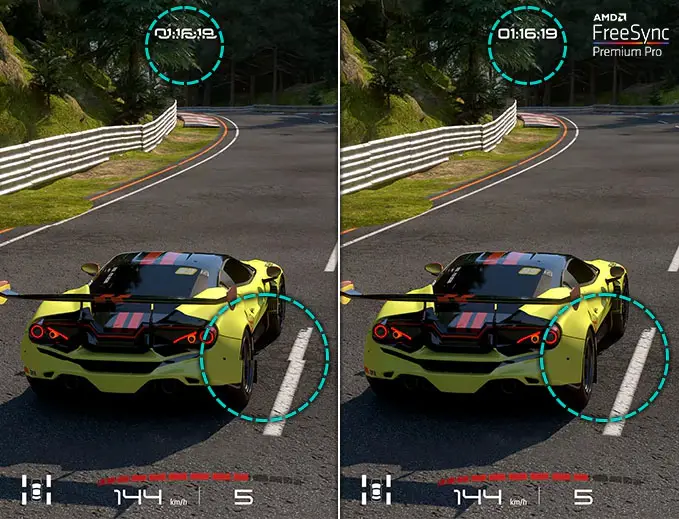
Input lag
If there is one area where Samsung constantly delivers even in their most budget friendly units is in the input lag measurements. And the QN85A didn’t disappoint us as with Game mode enabled we got an average of 10.7ms between 1080p and 4K resolutions which is just about what you need if you are a very serious gamer and need instant responses.
Outside of Game mode things are not so clear cut as different modes tend to give different results but in general we got an average of 74.1ms which is still good enough for casual and offline gaming where rapid response is not so crucial. The TV also comes with Auto Low Latency Mode (ALLM) and all the latest consoles support this which can be of great benefit.
Taking our F1 2019 copy for a spin in our PS5 gave us an amazing playing session with very fast responses to our commands and everything was rendering instantly on screen. So either you are a serious or casual gamer then the QN85A will totally cover your needs and then some.
Image quality impressions
The QN85A managed to scale nicely below the flagship QN90A while it is a clear upgrade compared to last year’s Q80T. With brightness exceeding 1000 nits, good viewing angles, excellent input lag, very nice upscaling capabilities, great color reproduction and solid motion performance the TV certainly ticks all the right boxes.

The main problem of LCD TVs was always blooming and the new mini LED backlight helps with this although it does not solve the problem completely. The QN85A still exhibits this problem even if things are slightly better than previous years so it seems there is still room for improvement in this regard.
Also no Dolby Vision will certainly make a lot of consumers to think twice and it’s definitely a decision that will continue to haunt Samsung for years to come.
Audio Quality
If there is one area that manufacturers are still struggling with after so many years is in the audio department. These ultra slim TVs simply don’t have the space required to equip them with audio systems capable at offering more immersion and better sound. We have seen most TVs lately incorporating various techniques and features but most of them are mostly software based and the end result is not much better than we could hope for.
It’s been a couple of years now that Samsung has developed their own audio system for their top flagships called Object Tracking Sound and as of 2021 there are four variants of this system depending its capabilities. We have the OTS Pro, OTS+, OTS and OTS Lite and for the QN85A Samsung has used the OTS variant. Keep in mind that the QN85A is the only Neo QLED that doesn’t come with the OTS Pro or OTS+ systems and has to settle with a more toned down version.
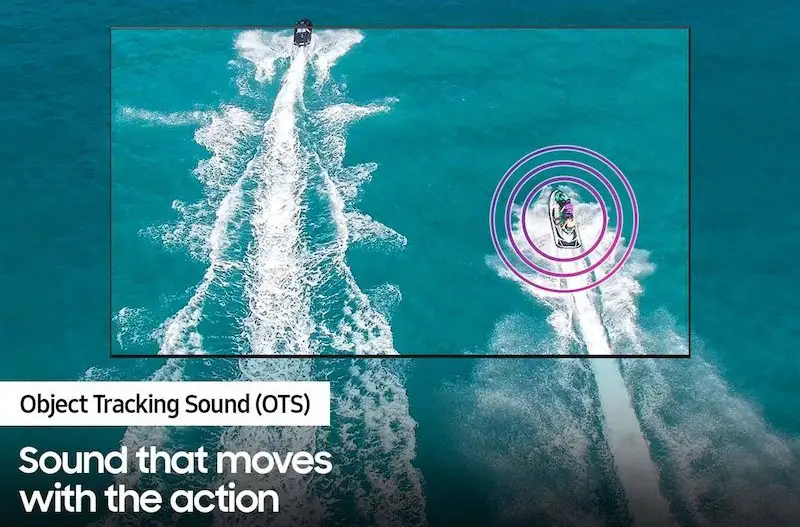
As such the QN85A features a 2.2.2 channels audio system with a power rating of 60 watts in total which is more than enough for casual viewing. The difference compared to the OTS+ is that the latter uses 4.2.2 channels instead making the sound be accurate when tracking what is on screen.
We had experienced the OTS+ on the QN90A and what we can tell you is that the OTS system in the QN85A indeed feels a bit inferior. Not by much, but the QN90A seemed to track the image movements much better than the QN85A. The effect is still there and you still get plenty out of it so unless you do a direct comparison you are not going to understand much of a difference. Dialogue was still very distinct and clear and the TV could go pretty loud without much annoying distortion.
The TV supports Dolby Audio but even with a system like OTS you shouldn’t have high hopes in terms of audio immersion and surround sound. If you want to get the most out of it then you will certainly need a dedicated audio system or at least a soundbar with surround speakers. Dolby Atmos can be passed-through the included eARC to some Dolby Atmos soundbar or dedicated sound system in this case. DTS support is completely absent once again this year as it is not only missing from native support but it cannot also be passed-through from any of the available ports which is rather disappointing.
The QN85A also comes with some added features we also saw in the QN90A. The first one worth mentioning is called Adaptive Sound+ with which the TV analyzes the content being played and for each scene can identify and render the best sound type. This whole process starts by separating and classifying audio input signals. Key characteristics are then pulled out and rendered to best suit the scene.
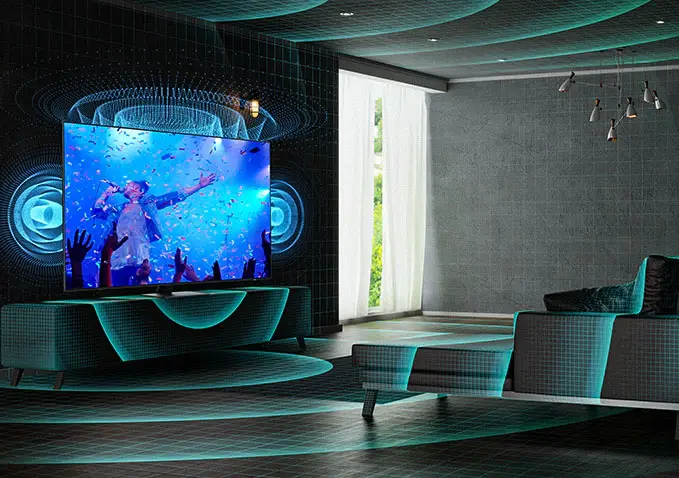
Another feature set is SpaceFit Sound along with Active Voice Amplifier (AVA). With the help of spatial analysis the TV can adapt to the different acoustics of each room. This is done by sending inaudible signals that analyze your room and can optimize the sound accordingly. And by using AVA the TV can detect environmental noise and enhance the voice output of the content you watch for a more pleasant viewing experience.
Lastly we get Q-Symphony which is a feature that you can use to combine the TVs audio system with an appropriate soundbar that also supports that. This way the audio will be synced and output from both devices for an even more immersive audio experience. Samsung has released a whole lineup of soundbars that support this feature in case you are thinking of getting one.
In terms of audio the TV is not all that different from the QN90A. It comes with the less capable OTS audio system which feels a bit less accurate compared to the one we got in Samsung’s flagship but other than that we got a pretty similar experience and with exactly the same audio features.
Ports and Connectivity
Many of the top tier Samsung TVs that don’t feature the One Connect box comes with exactly the same ports layout. And looking at the QN85A what we see is exactly the same that we saw in our QN90A review which is not very surprising as we have seen Samsung using the same ports layout across many of their models before. As we said above all ports are located on a special inset at the left side of the back panel with all of them looking sideways for easy access either you have it on a furniture or on the wall.
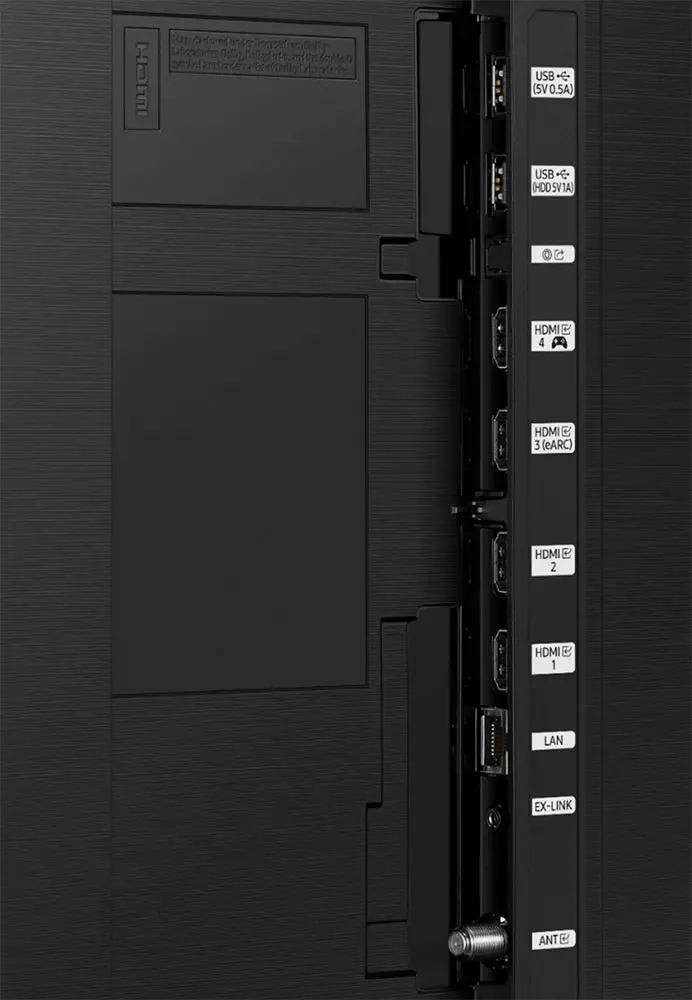
Starting from the top we find two USB ports for connecting external storage or streaming devices, a digital audio optical output, four HDMI inputs, an Ethernet port for wired connection to the internet, an Ex-Link jack and the usual antenna/cable connector.
Now as for the USB ports these are v2.0 which is greatly disappointing for such a high profile flagship. There is also a single HDMI 2.1 in position 4 while the rest of them are the older HDMI 2.0. The HDMI in position 3 also comes with eARC support which allows you to send high-quality object-based audio like Dolby Atmos to another device and is another handy feature that many seek nowadays.
As for it’s wireless capabilities the QN85A comes with the usual built-in WiFi and also with Bluetooth that is unfortunately the less capable v4.2 as the newer Bluetooth 5.2 is only used in the 8K TVs for this year.
OS, Apps and Features
All Neo QLEDs in 2021 get the latest version of Tizen which brings everything that was available last year along with a couple new additions to spice things up. The version in the QN85A is exactly the same as the one we saw in the QN90A so this part of our review is more or less the same but we will make changes wherever we deem necessary.
The 2021 version of Tizen is highly similar to previous years and the visual appearance of the new 2021 is no different from last year. Samsung retained the more dark visual design but this is purely an aesthetic thing and functionality remains as good as ever.

The general layout has remained completely the same with the launcher bar sitting at the bottom of the screen while a second row appears on top and offers several selections that include additional content and various suggestions. Customization couldn’t be missing as with so much content available it can become increasingly difficult to navigate through the apps and services especially if you use many of them at the same time. Tizen offers many customization options so you can re-arrange everything to your liking.
The first real addition this year is the Super Ultrawide GameView & Game Bar. This is an on-screen menu that lets you make real-time adjustments to screen ratio, input lag check, FPS, HDR, wireless headset settings and more. This can be a really handy feature to gamers as you don’t have to mess with menus every time you want to check on a specific setting. With this quick feature you have everything in front of you with the click of a button.
When it comes to content the Tizen platform is famous for it’s enormous support from developers. The QN85A offers practically all known services and platforms you can think of with Netflix, Apple TV, Disney Plus, Youtube, Amazon, Hulu, Rakuten, Demand 5 and BBC iPlayer just a few of the big names available. There is also Samsung TV plus which offers hundreds of subscription-free channels to choose from. Many of these services can playback in both 4K with HDR like Netflix and Amazon while in general navigating through several services felt smooth and without any noticeable lagging.
But if having so many apps available can be increasingly difficult for you then you can use a handy feature called “Universal Guide” which makes a return from last year. This is a feature that analyzes your viewing patterns and creates a ‘For You’ page that includes content you may be interested in seeing according to your viewing habits. So in case you are watching a specific series all the time this page can propose you to see the next available episode which can be a rather practical feature.
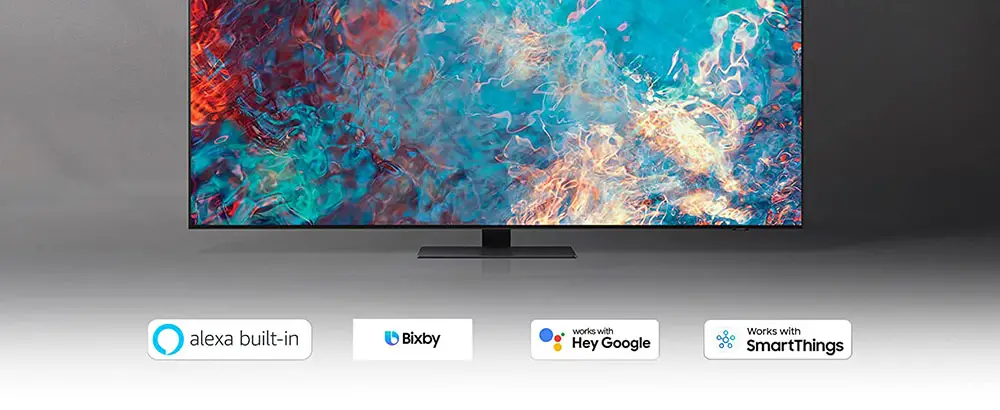
A function that has been retained from the last few years is SmartThings integration. With it you can make your TV the central hub of all your smart houses devices. These can be lights, electronic locks, alarms, vacuum robots, thermostats and everything that supports the SmartThings platform.
Obviously another feature that could not be missing is voice control. It seems that Samsung is really trying to market their own Bixby service but even if you are not very fond of that there is Amazon’s Alexa or Google Assistant to choose from. While if you are an Apple guy then don’t get disappointed as there is also Airplay support and you can use Siri through it for your voice commands.
One feature that we saw for the first time last year and makes a comeback is Multi-View and although at it’s core it’s not something entirely new Samsung took it a step further. Multi-View is basically a more advanced screen mirroring and with it instead of just simply projecting the screen from your mobile device on the TV you can choose to have two screens showing both TV content and what your mobile device shows. How useful this can be we leave it to you to decide because we are still scratching our heads for this one.
In addition to Multi-View there is also Tap View and with it you can mirror your phone on your TV with just a tap to continue enjoying movies, music, and apps on the bigger screen within seconds.
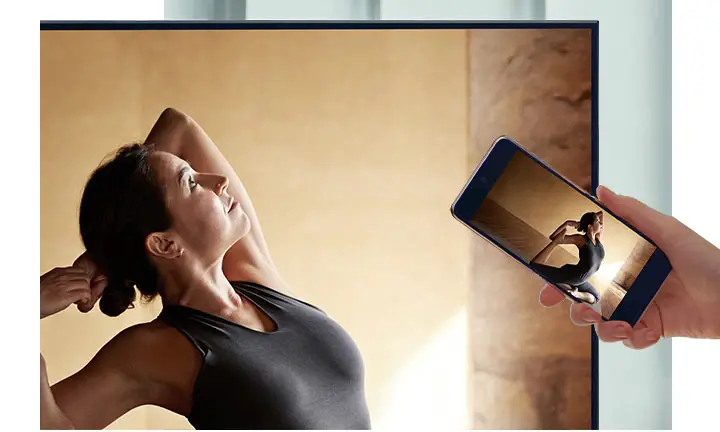
Another returning feature is Ambient Mode+ which is a slightly enhanced version of the Ambient Mode we get in many Samsung models for the last few years. With the plus version now except from the ability to display various images on the TV when not in use it can also project various information including weather updates, news headlines, photos and music.
Lastly we have one more new addition this year and this is Samsung Health. It seems that with the coronavirus pandemic and many people staying indoors Samsung thought that exercise at home would be on the rise. So many of their TVs this year come with Samsung’s program in order to stay in shape. If you like to exercise at home you may like this one but otherwise we don’t see this being used very much.
In general every year it seems that Samsung finds something new to squeeze inside their already fully packed system. Not much have changed in terms of basic design and layout but the addition of the useful Super Ultrawide GameView & Game Bar and the not so useful Samsung Health features do spice up things a bit more than already are. Tizen remains a behemoth in the Smart OS ecosystem and Samsung makes everything they can to keep it that way.
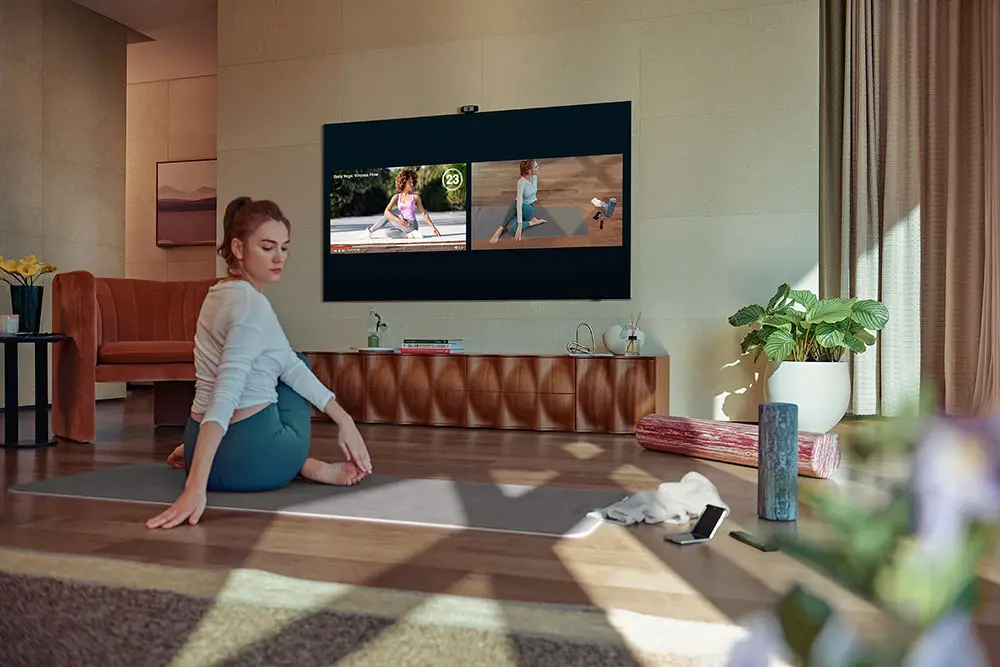
Final Thoughts
With the announcement of the new mini LED system we were afraid that only the top flagships will get the new backlight system. But the QN85A shows that while we are still in premium TV territory Samsung tried to offer it in a more lucrative price by scaling down some of its specs making this one a very interesting proposal for being a Neo QLED offering.
The QN85A brings all the high tech features every Neo QLED has which means it packs the new mini LED backlight system for tighter light control, uses the new Neo Quantum Processor 4K with its excellent up-scaling capabilities while it showcased very nice colors, great viewing angles, low input lag and solid motion performance making it an excellent proposal not only for movies but also for gaming. If you add the new Tizen with its latest additions and the inclusion of HDMI 2.1 with all its gaming centric features then there is not much missing here to be honest.
On the downsides while we saw an improvement with the new mini LED system blooming was still very much visible even if not in the same extent as it was before. Also as the TV is using an IPS-like panel, contrast was really mediocre and while local dimming did improve things slightly it was not a very drastic change. Lastly we are disappointed to see that for one more year Samsung remains the only big manufacturer that doesn’t support Dolby Vision and not only that, as there is no DTS either.
If you would like to get a taste of the new mini LED but you find the price of the top tier QN90A a bit too much then the Samsung QN85A is a very interesting proposal. It brings to the table almost everything the rest of the Neo QLEDs have but at a price that will certainly make things easier for your wallet. It has the performance and the features to stand among the rest in the premium category and while it may not be perfect in any way it will certainly provide you with countless hours of cinematic enjoyment.
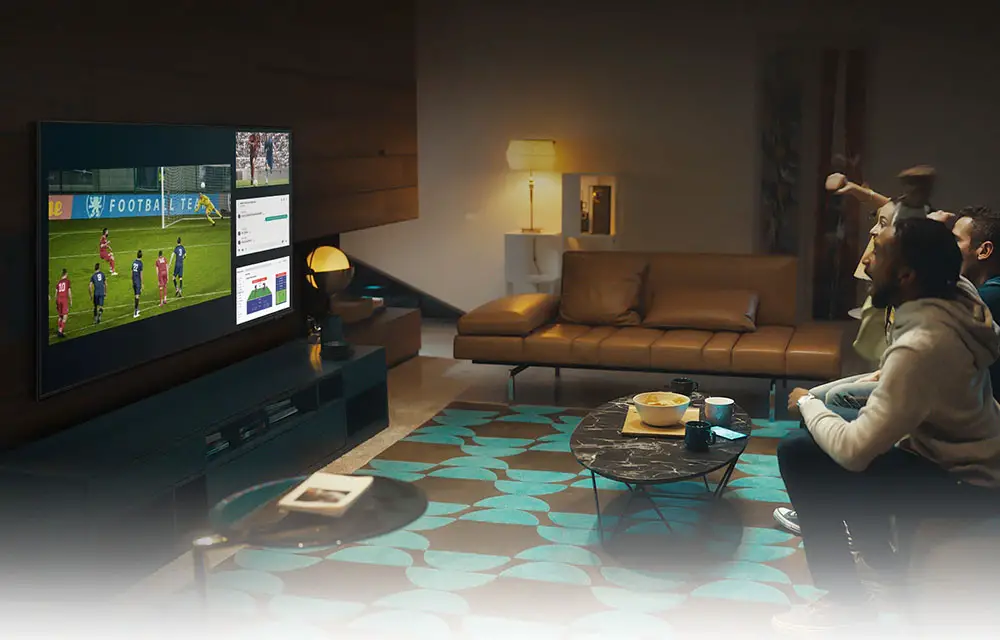
For more reviews you can check our dedicated 4K LED LCD TV reviews list or even look at our Product Reviews Table where you can find the brand and specific product you are looking for.
Cheapest Places to Buy :
*We are a reader-supported website. When you buy through links on our site, we may earn a small affiliate commission at no extra cost to you. Home Media Entertainment does not accept money for reviews.*
Hi Stratos
Thanks for sharing your review on the Samsung QN85A. Samsung has been my preferred brand for all the gadgets in home and I thought of doing some research on what is new TV wise. I would love to go for the QN90A but it’s a bit too expensive for me. And from what you say the QN85A is not all that bad, so I am seriously considering this.
Warm Regards,
Gaurav Gaur
Hey there. Yes, if the QN90A is too expensive for you the QN85A has many of the same features with a slightly better price. Obviously it’s not on par with the QN90A but the differences are not all that big and you still get the new mini LED backlight.
Hi there, thanks for the good reviews. I have a plan for replacing my old Samsung smart tv. Recently my consideration is Samsung the frame 55″ 2021 model. As I see, it has some special specs that other QLED models don’t, especially customizeable bezels, beautiful model, very thin body, slim fit wall mount, one connect box and good performance indeed.
But after see your review of QN85A, this one seems offer more promosing in quality of color and more high tech features, also it’s only second to the top tier QN90A.
Fyi, QN85A 55″ is just more expensive $100 than the frame 55″ 2021 here. They sell the frame 2021 bundle and come along with 2 pcs Customizeable bezels free.
My question, which one should worth to buy?
Hello Andrew. These two TVs belong in different categories so it depends what you are looking for. In terms of design the Frame has the edge with its custom frames and One Connect Box but if picture quality is what you are looking for the the QN85A is definitely the clear winner. The Frame is not meant to be a picture quality powerhouse. Yes, it has some good specs but Samsung made this for other reasons and not to offer you the most impressive images.
Ok. Thanks Stratos. Keep up the good work and stay safe there.
Thank you Andrew. Stay safe also!
Hi Stratos, thank you for sharing this article. The new Quantum Matrix Technology look really interesting although I am a bit disappointed that blooming is still visible. I was hoping that with so many dimming zones it would not be as extensive as it is. My question is do you think it is worth the money?
Well it’s not easy to answer that as every person expects different things. From what I have seen blooming has been improved a lot but is not entirely solved. In certain scenes it can be very obvious while in others you will not notice it at all. In my opinion you should check the TV from close and decide if this is something that will bother you or not.
LG QNED90 is better than QN85A?
They are about the same. The Samsung is brighter and has slightly lower input lag while the LG has slightly better colors. But overall their differences are very small.
It comes down to what you prefer the most. With Samsung you will get HDR10+ and Tizen while with the LG you get Dolby Vision and webOS.